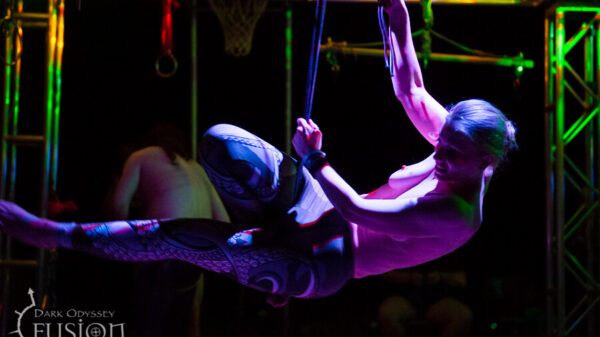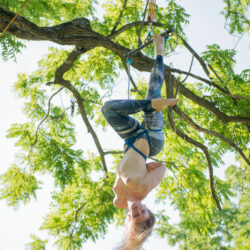 No one wants their bondage scene crashed by the nervepocalypse! Most incidents of nerve damage from bondage are not as straightforward as they might seem, but rather involve an interplay of multiple “horsepeople of the nervepocalypse.” Being aware of these factors can help you mitigate risks and stay in bondage “heaven!”
No one wants their bondage scene crashed by the nervepocalypse! Most incidents of nerve damage from bondage are not as straightforward as they might seem, but rather involve an interplay of multiple “horsepeople of the nervepocalypse.” Being aware of these factors can help you mitigate risks and stay in bondage “heaven!”
Note that this isn’t intended to be an exhaustive list of every possible factor, but rather an overview of some of the most salient ones, which include:
- Individual differences in nerve vulnerability
- Anatomical location (where on the body you are tying)
- Duration of force
- Severity and type of force (compression or shearing)
- Stretch or stress positioning
- Environment (internal & external)
In the rope community, we have a clear understanding of some of these risks (location and severity of compression), but other factors (such as the role of positioning) are often underappreciated.
Most incidents of nerve damage involve many factors, interacting in complicated ways. Let’s get to know these “Six Horsepeople of the Nervepocalypse” one at a time:
Some people seem to have “bombproof” nerves; others seem to get nerve damage if you look at them funny. Like many physiological traits, nerve vulnerability can be thought of as existing along a bell curve. Where a given individual sits on the curve is likely the result of an interplay of genetic and environmental factors.
There are a number of health conditions that increase vulnerability to nerve damage. These include diabetes, thyroid or kidney disease, some autoimmune diseases, and poor nutrition or vitamin deficiency (especially vitamins B6 and B12). Very thin people are at higher risk for acute compression nerve injury.1
There is good evidence, both in the bondage community and via scientific research, that nerve damage is cumulative; existing subclinical (asymptomatic) nerve injury is a risk factor to develop a symptomatic nerve injury.2 This means that perhaps a bottom who has been in a box tie the exact same way 50 times and never had symptoms of nerve damage might experience a symptomatic nerve injury the 51st time, even though there was nothing special, different, or particularly “wrong” that 51st time.
Where on the body you are placing load-bearing rope will certainly affect your risk. Some locations are generally higher risk than others, and people will often have different areas of vulnerability. Joints and arms are generally higher risk areas, as compared to thighs or feet.
The radial nerve in the arm (particularly the mid upper arm) is a common site of bondage nerve damage. “The radial nerve is the most frequently injured major nerve in the upper extremity.”3 Injury to this nerve can cause various sensory and motor deficits; in some cases it can be quite debilitating. Face down or face up box tie/TK suspensions seem to be especially high risk.
Knees, elbows, groin, and armpits are places that major arteries, veins, and nerves are near the surface. There’s a reason you don’t see too many bottoms strung up by their elbows… and there have been some truly disastrous case reports when people have tried.
The lateral femoral cutaneous nerve (LFCN) seems to be the most commonly injured lower extremity nerve. Injury to this nerve causes numbness to a patch of the outer thigh. This most frequently occurs in face down or side suspensions that heavily load a hip harness, or in ebi/”shrimp” positions – see the 5th point below for more details on positioning.
Nerve damage happens in stages. Removing bondage at the first signs of injury can keep a minor injury from becoming a major one.
I have heard people say that “once the damage is done it’s done, and there’s nothing you can do about it.” This is true in the sense that there is no quick cure for nerve damage, and prevention is by far the better strategy. However, I have also heard this in the context of: “well, no, I didn’t quickly untie their arm when they said they couldn’t move their hand, because the damage was already done at that point.” This is a gross misunderstanding of the mechanisms involved.
While it’s true that once damage has occurred you can’t quickly fix it, nerve damage isn’t an “all or nothing” thing – it happens in degrees. There are several grading systems that are used to  describe nerve damage. The most common divides nerve injury into three categories according to severity: neurapraxia, axonotmesis, and neurotmesis. Another commonly used classification system divides nerve injury into five categories, first to fifth degree.4 Neurapraxia or first-degree injury involves only temporary functional loss (conduction blockage likely caused by local ischemia4), while injuries on the other end of the spectrum involve complete severance of the nerve from which there will be no recovery without surgical intervention, and maybe not even then.
describe nerve damage. The most common divides nerve injury into three categories according to severity: neurapraxia, axonotmesis, and neurotmesis. Another commonly used classification system divides nerve injury into five categories, first to fifth degree.4 Neurapraxia or first-degree injury involves only temporary functional loss (conduction blockage likely caused by local ischemia4), while injuries on the other end of the spectrum involve complete severance of the nerve from which there will be no recovery without surgical intervention, and maybe not even then.
Even within these grading systems, injury happens on a gradient, not step-wise. So releasing that limb from bondage right away might be the difference between a first degree injury that resolves in a few hours, or a third degree injury that means your bottom can’t write (and can’t work) for a month after your scene. “Identical neural injury times do not always lead to the same neural injury”5 – here, as well, there is a large amount of individual variation.
4) Severity of compression/amount of shearing force.
There are two main types of forces that rope can apply against the body. Compression occurs when the force is aligned with the body, for example rope pressing directly up into an armpit. Shearing occurs when forces are not aligned with the body, for example when rope under load slides around the hips.
The increased severity of compression and risk of shearing are part of what makes suspension bondage generally higher risk than floor work. “The degree of [nerve] injury is related to the severity and extent (time) of compression.”4 In general, longer duration and more extreme compression/shearing will result in more severe injury.
You can dramatically reduce compression force by applying less load or by having more (evenly tensioned) bondage material against the skin. This is what makes tying up someone’s wrists with a fluffy scarf generally lower risk than restraining them with a zip tie. If you’re using rope, this can mean making more wrapping turns, carefully monitoring tension, or using thicker rope (although thicker rope has it’s own problems, like very bulky knots).
5) Stretch/stress positioning
In some cases, it is not the rope itself that compresses the nerve, but rather the position of the body. “Stretch-related injuries are the most common type [of nerve injury seen in clinical practice]. Peripheral nerves are inherently elastic… but when traction forces exceed the nerve’s capacity to stretch, injury occurs.”3 Nerve damage can be caused by extended positions, either due to direct stretching and strain on the nerve or because the stretch causes a nerve to be pressed up against another body structure (such as a boney prominence). As well as happening in stretched or extended positions, positioning nerve injuries can occur due to flexed or “bent” positions. This is especially common in ebi/“shrimp” ties, where the person in bondage is folded over their own legs for an extended period of time.
Tolerance for stretch also has a lot of individual variance – are you noticing that as a theme here? Additionally, stress positioning may expose nerves and make them more vulnerable to external compression (think of how a tight rubber band is more susceptible to damage than a relaxed one). All these factors play together in complicated ways.
6) Environment (internal & external)
This is a rather broad category, and can include factors like communication and trust between partners, use of intoxicants, hydration, and more. This article will focus on two possible environmental factors: temperature and performance.
 Studies on intraoperative positioning nerve injuries (which are similar to bondage injuries in numerous ways) demonstrate that cold is a risk factor for nerve damage.2 Revisiting the rubber band – think of how much more brittle a frozen rubber band is than a warm one. Cold also decreases your flexibility and alters your sensory perception. Therefore, doing bondage in an icebox or outside in the winter has a high risk profile. Additionally, warming up prior to being tied may help prevent injury.
Studies on intraoperative positioning nerve injuries (which are similar to bondage injuries in numerous ways) demonstrate that cold is a risk factor for nerve damage.2 Revisiting the rubber band – think of how much more brittle a frozen rubber band is than a warm one. Cold also decreases your flexibility and alters your sensory perception. Therefore, doing bondage in an icebox or outside in the winter has a high risk profile. Additionally, warming up prior to being tied may help prevent injury.
Another important environmental risk factor is having an audience. Being in a performance setting can alter your body awareness (and connection with your partner) in a myriad of ways. The adrenaline rush of the spotlight often greatly increases pain tolerance, and performers frequently “push through” warning signs of injury because “the show must go on.”
Avoiding the Nervepocalypse
What can you do to avoid the six horsepeople of the nervepocalypse crashing your bondage scene? Be aware of different kinds of nerve pain – numbness (especially if it is localized to a smaller area rather than the entire bound extremity), burning, a sharp or cold feeling, tingling – and do frequent checks. Consider your allowable “risk budget” and where you want to allocate it. Note and address symptoms of nerve damage rapidly. “Recovery of nerve function is more likely with a mild injury and shorter duration of compression.”2 Be sure you always have a reliable, safe cutting implement within reach, and know when and how to safely use it. For partnered bondage, empower your partner(s) to communicate with you. Don’t let your ego get you into (too much) trouble.
Surviving the Nervepocalypse
Sometimes, despite everyone’s best intentions, an injury occurs. Make a plan for mishaps like this before they happen, handle injuries in a supportive manner, implement appropriate first aid measures, and know when to seek medical evaluation. Hopefully you’ll recover quickly, and ease back into bondage having taken lessons from your bout with the six horsepeople!
References:
- Stewart JE. (2000) Focal peripheral neuropathies. 4th Ed.
- Winfree C, Kline D. (2005) Intraoperative positioning nerve injuries. Surgical Neurology.
- Burnett M, Zager E. (2004) Pathophysiology of peripheral nerve injury: A brief review. Neurosurgical Focus
- Peripheral Nerve Entrapment and Injury in the Upper Extremity, Am Fam Physician. 2010 Jan
- Clinical Features of Wrist Drop Caused by Compressive Radial Neuropathy and Its Anatomical Considerations, Journal of Korean Neurosurgical Society
About the author:
This article was written by Shay Tiziano, a medical professional and avid self-suspender who has spent waaayyyy too much time geeking out over bondage safety. Shay also got input on the ideas in this post from two kinky MDs (Dr. Who and Miette Rouge), as well as from other awesome people (including BacoNawa & Deadheavy) and sources too numerous to list (although you can start here). This article is informational only and offered with intentions of promoting risk awareness. It is not a substitute for using your own judgement, and is not medical advice. Want more from Shay? Check out StefanosandShay.com, TwistedWindows.com, Remedialropes.com, and Selfsuspend.com!
